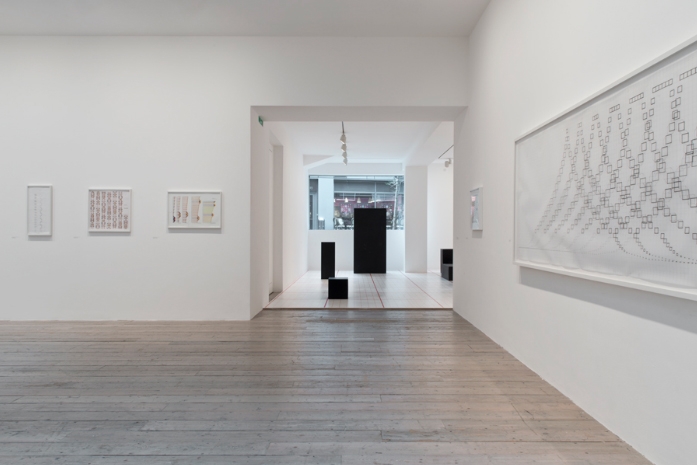This exhibition reconfigures the first retrospective of work by Channa Horwitz (1932 – 2013) since her death, which was held at the KW Institute for Contemporary Art in Berlin in 2015. Hung over Raven Row’s marble fireplaces, the drawings on graph paper or Mylar, by the pioneering Californian conceptualist, might look like elegant and painstaking formal compositions, but the artist’s work, since the 1960s has been a celebration of generative constraints and a reminder that creativity thrives within structures and limits.
The show includes the sketches for Horwitz’s kinetic sculpture Suspension of Vertical Beams Moving in Space (1968), which formed her proposal for LACMA’s Art and Technology initiative (1966-1971), and which paired artists with scientists and engineers. Although Horwitz’s proposal was unrealised (the project, in the end, included work by only 67 male artists), this attempt to map the motion of the sculpture led her to develop her signature notation systems, the seminal Sonakinatography series (1968, until her death). Sonakinatography visually recalls familiar sequential structures, like musical staves, film strips or woven textiles.The series displayed give a glimpse of the diversity of combinations achievable by arranging eight little squares of different colours on eight-square grids, according to varying compositional rules. In a 1976 interview in Flash Art, Horwitz indicated a sometimes unconscious intention to ‘travel into the unknown’ as the real motor of her work, a drive to explore the infinite possibilities provided by a universe of her own construction. Most of the works in the first and second floor galleries stem from these principles. Lines and angles evolve in intricate geometric patterns, infused with a serene glow from the coloured inks and paints used, while retaining the prosaic traces of their hand-made manufacture.
Horwitz’s diagrams refer to parameters like duration, rhythm and movement, and she encouraged the translation of these works as directives for choreographies, musical performances and even yoga sessions. Performances took place at weekends as part of this exhibition, including yoga by Y8 Artyoga studio from Hamburg. Within a reconstruction of Horwitz’s installation Displacement, originally made with Y8 in 2011, six participants dressed in white practise yoga on an orange grid, while choreographing black rectangular blocks. Here again the beauty lies in the contrast between disciplined execution and human interactions.
Not dissimilar from the use of proportional devices like the golden ratio in figurative art and architecture, Horwitz’s use of compositional structures highlights how we create and work within defined systems and structures. Her practice revels in the endless potential offered by the obstinate adherence to these systems, while at the same time any visible transgression or mistake, makes the work also intensely, candidly human.
November 2016
